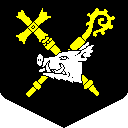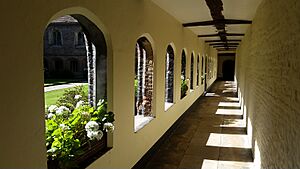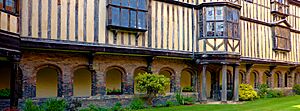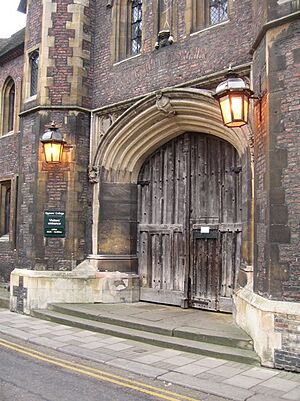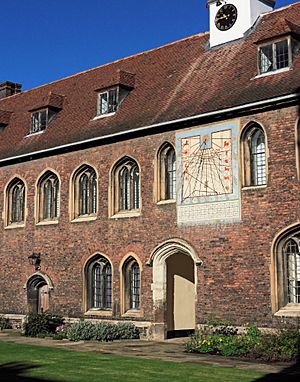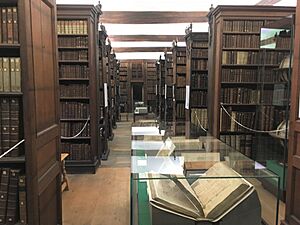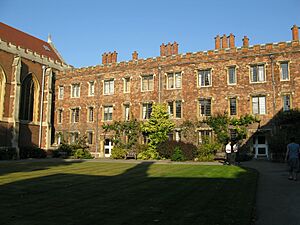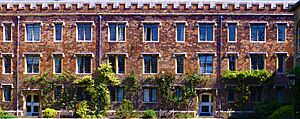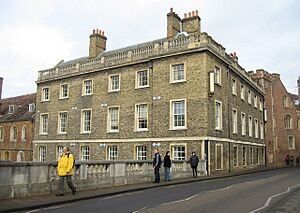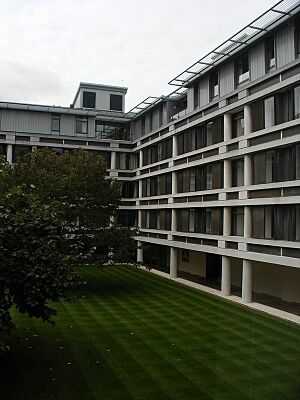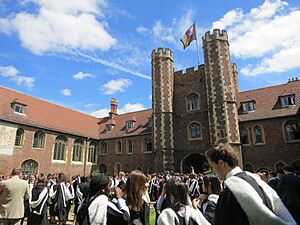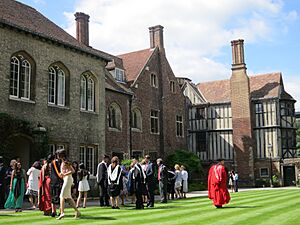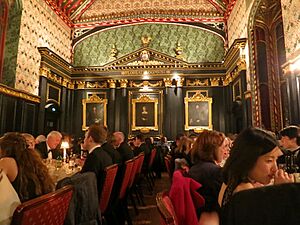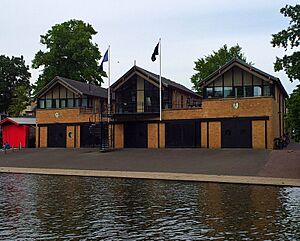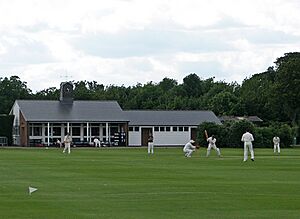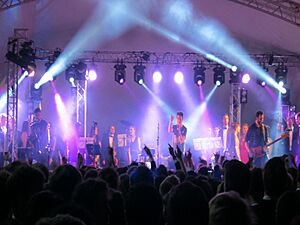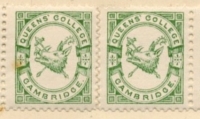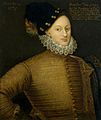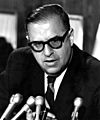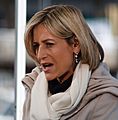Queens' College, Cambridge facts for kids
Quick facts for kids Queens' College |
||||||||||||
|---|---|---|---|---|---|---|---|---|---|---|---|---|
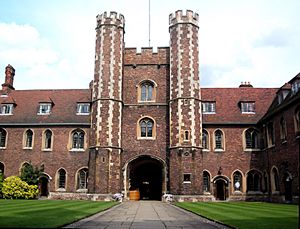
Queens' College Gatehouse
|
||||||||||||
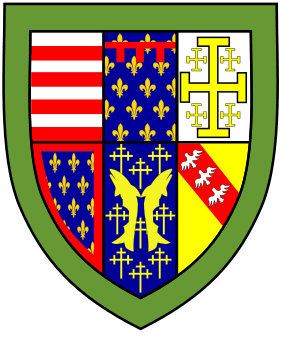
Arms of Queens' College, being the arms of Margaret of Anjou
|
||||||||||||
|
|
||||||||||||
| University | University of Cambridge | |||||||||||
| Location | Silver Street (map) | |||||||||||
| Full name | The Queen's College of St Margaret and St Bernard | |||||||||||
| Abbreviation | Q | |||||||||||
| Motto | Floreat Domus (Latin) | |||||||||||
| Motto in English | May this house flourish | |||||||||||
| Founders |
|
|||||||||||
| Established | 1448 Refounded 1465 |
|||||||||||
| Named after |
|
|||||||||||
| Sister colleges |
|
|||||||||||
| President | Mohamed A. El-Erian | |||||||||||
| Undergraduates | 546 (2022-23) | |||||||||||
| Postgraduates | 544 (2022-23) | |||||||||||
| Map | ||||||||||||
| Lua error in Module:Location_map at line 420: attempt to index field 'wikibase' (a nil value). | ||||||||||||
Queens' College is a famous college that is part of the University of Cambridge in England. It's one of the oldest colleges, started in 1448 by Margaret of Anjou. What makes Queens' special is that its buildings are on both sides of the River Cam. The famous Mathematical Bridge and Silver Street connect these two parts.
Many well-known people have studied at Queens' College. These include Desiderius Erasmus, a famous scholar from long ago, and more recently, author T. H. White, politician Abba Eban, and actor Stephen Fry. Other notable alumni include newsreader Emily Maitlis, Governor of the Bank of England Andrew Bailey, and award-winning mathematician James Maynard.
As of June 2023, the college had assets worth £179 million. The current head of the college is economist Mohamed A. El-Erian.
Contents
A Look at Queens' College History
Queens' College was first started in 1448 by Margaret of Anjou. Later, it was restarted in 1465 by Elizabeth Woodville, who was a rival queen during the Wars of the Roses. This is why the college name is spelled "Queens'" (plural), not "Queen's" (singular). Its full name is "The Queen's College of St Margaret and St Bernard."
In 1446, a man named Andrew Dokett got permission to start a college called St Bernard's. A year later, Queen Margaret received the land to build a new college. On April 15, 1448, the first stone of the chapel was laid.
By 1460, the library, chapel, and other main buildings were finished. Over the years, many improvements and new buildings were added. The Walnut Tree Building, for example, was finished in 1618.
In the early 1600s, Queens' became a popular college for wealthy families. During the English Civil War, the college supported the King. Because of this, the college president and teachers were removed from their jobs. They were brought back in 1660.
In 1777, a fire damaged the Walnut Tree Building, which was then rebuilt. In 1795, the college was badly flooded, with water reportedly waist-deep in some areas.
In 1823, the college officially changed its name spelling from "Queen's" to "Queens'". The college's boat club started around 1831. In 1980, Queens' College began accepting female students for the first time. The first female students graduated in 1983.
Understanding the College Coat of Arms
The college's main symbol, its coat of arms, comes from Queen Margaret of Anjou. It shows six different areas she claimed. This design is interesting because it uses gold on silver, which is unusual in heraldry (the study of coats of arms).
The College Badge
The silver boar's head is not the official coat of arms, but a special badge. A white boar was the symbol of King Richard III. The college has used a boar's head as a symbol since 1544. The gold cross stands for St Margaret, and the gold staff for St Bernard. These are the two patron saints of Queens' College. This badge is often seen with college clubs and dining events.
Exploring Queens' College Buildings
Queens' College is special because its first buildings were designed as a complete college from the start. This means it had everything needed in one place: homes for students, a dining hall, kitchens, a library, and a chapel. Unlike many other colleges that changed their old buildings, Queens' kept its original medieval style because it couldn't afford big changes. This makes Old Court one of the best-preserved medieval areas in Cambridge.
Today, Queens' has some of the most recognizable buildings in Cambridge. It mixes old medieval architecture with newer modern architecture. It's one of only two Cambridge colleges that has buildings on both sides of the River Cam. The two sides are connected by the famous Mathematical Bridge. Students often call the two sides the "light side" and the "dark side." Queens' College is located south of the city center.
Cloister Court Buildings
The President's Lodge at Queens' is the oldest building along the river in Cambridge, built around 1460. It's part of Cloister Court. The covered walkways in the Cloister were added in the 1490s to connect the older parts of the college. The Essex Building in this court was built between 1756 and 1760.
Old Court Buildings
Old Court was built quickly between 1448 and 1451. It was likely designed by Reginald Ely, who also worked on King's College. While King's used expensive stone, Queens' Old Court was built with cheaper stone and red brick. Queens' was finished in just two years!
The War Memorial Library is the current student library. It used to be the original chapel in Old Court. It was named to honor Queens' College members who died in World War II.
The Old Library
The Old Library was built in 1448 as part of Old Court. It's one of the first libraries in Cambridge built just for books. It holds nearly 20,000 old books and papers. What's cool is that most of the printed books still have their original covers. This is because the college wasn't rich enough to re-cover them all, which was a popular trend long ago. It also has some of the earliest English celestial globes, which were once owned by a Queens' math teacher.
Walnut Tree Court Buildings
Walnut Tree Court was built between 1616 and 1618. The Walnut Tree Building on the east side was damaged by fire in 1777 and rebuilt. This area used to be the site of an old monastery. The walnut tree in the court is a replacement for an older one that gave the court its name.
The college chapel in Walnut Tree Court was designed by George Frederick Bodley and finished in 1891. It looks like a traditional church with rows of seats. The paintings on the altar are from the late 1400s and show scenes from the Bible.
Friar's Court Buildings
As more students joined in the 1800s, Queens' needed more places for them to live. Friars' Building was built in 1886 for students. It was named after the old monastery that used to be nearby.
Next to Friars' Building is the Dokett Building, built in 1912. It stands where old homes, supported by a former college president, used to be. This building was renovated in 2014.
The Erasmus Building, built in 1959, is the first college building on the Backs (a famous area by the river) to have a modern design. Its modern look caused some debate at the time. It was opened by the Queen Mother in 1961.
Cripps Court Buildings
Cripps Court, which includes Lyon Court (named after the Queen Mother), was built in stages between 1972 and 1988. It's a large, modern building that houses student rooms, a bar, a gym, squash courts, dining areas, and a big auditorium called The Fitzpatrick Hall. It was a gift from the Cripps Foundation. A fourth floor was added in 2007 for more student rooms and offices.
Fisher Building
Named after St John Fisher, this building was put up in 1936. It was the first student housing in Queens' to be west of the river. It was also the first building in Queens' to have bathrooms and toilets on each floor near the student rooms.
The Mathematical Bridge
The Mathematical Bridge (also called the Wooden Bridge) crosses the River Cam. It connects the older part of the college (the "dark side") with the newer western part (the "light side" or "The Island"). It's one of the most photographed spots in Cambridge.
There's a popular story that Sir Isaac Newton designed and built the bridge without any nuts or bolts. The story says students tried to take it apart and couldn't put it back together without bolts. But this story isn't true! Newton died 22 years before the bridge was built. It was built in 1749 by James Essex the Younger, designed by William Etheridge.
The bridge was repaired in 1866 and completely rebuilt in 1905 using teak wood. The new bridge has more visible bolts, which might be why the myth started.
Academic Life at Queens'
Queens' College welcomes students for all kinds of subjects. Like other Cambridge colleges, students go through an interview process. For some courses, students might need to take an admission test beforehand.
Undergraduate students at Cambridge learn through a "tutorial system." This means they have small group sessions with teachers, often at the college. Teachers and academic supervisors at the college are very important for student success. The college also has a large library that adds to the university's libraries.
In 2016, Queens' College was ranked sixth in the Tompkins Table. This table ranks Cambridge colleges based on how well their students do academically. In 2019, 32.58% of Queens' undergraduates achieved top grades.
Student Life at Queens'
Queens' College has many facilities for students. These include the chapel, the main dining hall, two libraries, a bar, and common rooms for students and teachers. There are also large gardens, sports fields, and a boat house. The college even has its own punts (flat-bottomed boats) that students can borrow.
Most undergraduate students live on the main college site. Other students usually live in Owlstone Croft, a college residence about a fifteen-minute walk away. Students can eat in the main hall, where formal meals are served and students wear academic gowns, or in the buttery, which is a more casual cafeteria.
Queens' is known as one of the more open and relaxed colleges in Cambridge. It offers facilities for many sports and arts. Student societies, like the Junior Combination Room (for undergraduates) and the Middle Combination Room (for postgraduates), organize various activities. There are many clubs, from wine tasting to drama and the Queens' College Boat Club.
Queens' also has a strong reputation for music and drama. The Fitzpatrick Hall provides a space for plays and concerts for students from across the university.
Sports at Queens'
The college has a rich history in sports and has been very successful in many major sports offered at Cambridge. It has its own sports grounds, a boat-house, squash courts, and a gym.
The college rowing club, Queens' College Boat Club, is one of the oldest at the university, dating back to 1831. Its boathouse was built in 1986. The club takes part in annual rowing races on the River Cam, called Lent Bumps and May Bumps.
Queens' College Rugby Football Club (QCRFC) plays Rugby Union against other Cambridge colleges. Many famous rugby players have come from Queens', including Mike Gibson and John Spencer.
The college football club, QCAFC, has also had great success, winning the Cuppers knockout cup in 2010–11 and the league title in 2015–16. Queens' is also traditionally strong in cricket.
The May Ball
Every two years, the college hosts a big, fancy event called the May Ball. It's very popular, and tickets are usually only for Queens' members and their guests. Highlights include amazing fireworks and live music from famous bands like Florence and the Machine and Kaiser Chiefs. In 2013, Queens' May Ball celebrated its 100th anniversary.
College Traditions
College Grace
A special prayer, called the college grace, is usually said before and after dinner in the main hall. A student who has a scholarship usually says the grace before dinner. The President or a senior teacher says the grace after dinner. A simpler English grace is now often used after dinner:
For these and all his mercies, for the queens our foundresses and for our other benefactors, God's holy name be blessed and praised. God preserve our King and Church.
| Grace | Latin | English |
|---|---|---|
| Ante Prandium (Before Dinner) |
Benedic, Domine, nos et dona tua, quae de largitate tua sumus sumpturi, et concede, ut illis salubriter nutriti tibi debitum obsequium praestare valeamus, per Christum Dominum nostrum. | Bless, O Lord, us and your gifts, which from your bounty we are about to receive, and grant that, healthily nourished by them, we may render you due obedience, through Christ our Lord. |
| Post Prandium (After Dinner) |
Gratias tibi agimus, sempiterne Deus, quod tam benigne hoc tempore nos pascere dignatus es, benedicentes sanctum nomen tuum pro reginis, fundatricibus nostris caeterisque benefactoribus, quorum beneficiis hic ad pietatem et studia literarum alimur, petimusque ut nos, his donis ad tuam gloriam recte utentes, una cum illis qui in fide Christi decesserunt, ad coelestem vitam perducamur, per Christum Dominum nostrum.
Deus, salvam fac Regem atque Ecclesiam. |
We give you thanks, eternal God, that so kindly at this time you have deigned to feed us, blessing your holy name for the queens, our foundresses, and our other benefactors, by whose benefits we are nourished here towards piety and the study of letters, and we ask that we, rightly using these gifts for your glory, together with those who have died in the faith of Christ, may be brought to the life in heaven, through Christ our Lord.
God preserve the King and Church. |
College Rivalry
Queens' College has a friendly competition with St Catharine's College. This started when St Catharine's built its main court, which made one side of Queens' College face a back alley.
College Stamps
Queens' was one of only three Cambridge colleges that used to print its own stamps. From 1883, students could buy these stamps to pay for college messengers to deliver their mail. This stopped in 1886 because it went against the national postal service's rules.
Queen Mother's Standard
When the college's patroness, Queen Elizabeth, the Queen Mother, passed away, she gave the college the special right to fly her personal flag. This flag is flown every year on the first day of the Michaelmas term (the autumn term) in her memory.
Walking on the Grass
Unlike most colleges at Oxford and Cambridge, students and even teachers at Queens' are not allowed to walk on the grass.
Famous People from Queens' College
Notable Former Students
-
Erasmus, a famous scholar and theologian.
-
Edward de Vere, a nobleman in the time of Queen Elizabeth I.
-
John Whitgift, who became Archbishop of Canterbury.
-
Alexander Crummell, a minister and the first black graduate of Cambridge University.
-
Charles Villiers Stanford, an Irish composer.
-
T. H. White, author of the King Arthur novels.
-
Abba Eban, an Israeli politician.
-
Stephen Fry, a well-known actor, author, and comedian.
-
Prince Salman bin Hamad al Khalifa, the Prime Minister of Bahrain.
-
Andrew Bailey, the current Governor of the Bank of England.
-
Emily Maitlis, a British journalist and newsreader.
-
Demis Hassabis, a computer scientist and founder of DeepMind.
-
Suella Braverman, a former government minister.
-
Luc Frieden, the Prime Minister of Luxembourg.
-
James Maynard, a number theorist and winner of the Fields Medal.
| Name | Birth | Death | Career |
|---|---|---|---|
| Desiderius Erasmus | 1466 | 1536 | Humanist, theologian, philosopher |
| John Whitgift | 1530 | 1604 | Archbishop of Canterbury |
| Edward de Vere | 1550 | 1604 | Elizabethan courtier, poet |
| Sir Oliver Cromwell | 1566 | 1655 | Landowner, lawyer and member of the House of Commons |
| John Hall | 1575 | 1635 | Notable physician, and son-in-law of William Shakespeare |
| Alexander Crummell | 1819 | 1898 | Priest, African nationalist |
| Osborne Reynolds | 1842 | 1912 | Innovator in fluid dynamics |
| Charles Villiers Stanford | 1852 | 1924 | Music composer |
| Sir Shenton Thomas | 1879 | 1962 | Last Governor of the Straits Settlements |
| Tin Tut | 1895 | 1948 | Burma's first Foreign Minister |
| Sir Roland Penrose | 1900 | 1984 | Artist, historian and poet |
| Gilbert Harding | 1907 | 1960 | Journalist and radio and television personality |
| T. H. White | 1906 | 1964 | Writer, best known for his King Arthur novels. |
| William Ofori Atta | 1910 | 1988 | Ghanaian Foreign Minister |
| Abba Eban | 1915 | 2002 | Israeli Foreign Affairs Minister |
| Stephen Fry | 1957 | Comedian, writer, actor, novelist | |
| Mohamed El-Erian | 1958 | Economist and investment analyst | |
| Andrew Bailey | 1959 | Governor of the Bank of England | |
| Luc Frieden | 1963 | Prime Minister of Luxembourg | |
| Tom Holland | 1968 | Author and historian | |
| Prince Salman bin Hamad al Khalifa | 1969 | Crown Prince and Prime Minister of Bahrain | |
| Stephen Kinnock | 1970 | Labour Party MP | |
| Emily Maitlis | 1970 | BBC newsreader and journalist | |
| Liz Kendall | 1971 | Labour Party politician | |
| Demis Hassabis | 1976 | Founder of DeepMind | |
| Khalid Abdalla | 1980 | Actor known for United 93 | |
| Suella Braverman | 1980 | Conservative Member of Parliament (MP) | |
| Simon Bird | 1984 | Actor in E4 comedy series The Inbetweeners | |
| Jamie Roberts | 1986 | Welsh rugby union player | |
| James Maynard | 1987 | Number Theorist and Fields Medal recipient | |
| Hannah Murray | 1989 | Actress in Skins and Game of Thrones |
College Presidents
-
Saint John Fisher, president 1505–1508
-
Herbert Palmer, president 1644–1647.
-
Isaac Milner, president 1788–1820.
-
Lord Oxburgh, president 1982–1989
-
Sir John Polkinghorne, president 1988–1996
Royal Patronesses
Queens' College had royal support in its early years. After a long break, Elizabeth Bowes-Lyon, the late Queen Mother, became the college's patron to mark its 550th anniversary. A portrait of her hangs in the Senior Combination Room, and a newer part of the college, Lyon Court, is named after her.
Queen Elizabeth II was also a patron of the college from 2003 until her passing in 2022.
Queens' College in Pop Culture
The college has appeared in books, movies, and TV shows.
- Darkness at Pemberley (1932 novel) by T. H. White features "St Bernard's College," which is a made-up version of Queens' College.
- In 1984, Queens' was the subject of an eight-part BBC documentary called Queens': A Cambridge College.
- The movie The Bourne Supremacy (2004) has many hints and references to Cambridge colleges, especially Queens'. The director and one of the producers had studied there.
- Eskimo Day (1996 TV Drama) is about parents and teenagers during an admissions interview day at Queens' College.
- The film Starter for 10 (2006) includes a scene filmed at Queens' College, showing a TV quiz show.
- In the TV series Kingdom (2007–2009), the main character, played by Stephen Fry, returns to Cambridge. Although the college isn't named, it's Queens' that appears on screen, where Fry himself was a student.
- The Old Hall was used for the music video for the song "Things We Lost in the Fire" by the band Bastille.
- The college is the setting for the "Secret Diary of a Porter Girl" blog, written by a former college staff member.
Images for kids
See also
 In Spanish: Queens' College (Cambridge) para niños
In Spanish: Queens' College (Cambridge) para niños



